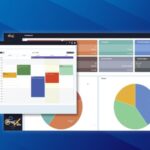When visitors enter the new Vertex Pharmaceuticals corporate headquarters building in Cambridge, Mass., an enormous 2×8-array video wall made up of 55-inch Primeview Ultra Narrow Bezel monitors greets them with the company’s new corporate branding, product news and information and company history.
The effect is striking and reflects the modern design throughout the building.
The use of the HDBaseT-enabled Primeview displays not only saved thousands of dollars in materials and labor costs, but also keeps maintenance costs low and ensures the video wall is futureproof in the event the company wants to leverage higher bandwidth video content.
Vertex built its corporate headquarters to bring employees spread out across disparate locations together into one modern space. The new building features close to 100 conference rooms with open designs that better facilitate collaboration, and a large space for all-staff meetings. The Welcome Center mirrors that design, with the reception and large open seating areas directing visitors’ eyes to the video wall. Each 2×2 array can display static image slideshows, information, videos and RSS feeds.
Editor’s Note: You’ve Got HDBaseT; Do You Still Need an Electrician?
Vertex brought on AV consultant ACT Associates, based in Storrs, Conn., as the project designer. ACT turned to Primeview to provide the HDBaseT-enabled displays to reduce the time and costs of installation. Video walls are a natural fit for integrators to implement HDBaseT because of the technology’s all-in-one ability to send uncompressed full HD digital video, audio, 100BaseT Ethernet, power over cable and various control signals through a single LAN cable.
The Vertex video wall is configured with 16 55-inch Primeview LCD monitors divided into four 2×2 arrays with a total of eight inputs. Each 2×2 array accounts for one signal. There are seven computer inputs and one digital signage input, the latter incorporating a Visix media player. Four outputs are currently in use, so the system has room to grow in the event Vertex decides to leverage 3D and 4K video content.
“From an installation perspective, HDBaseT just made wiring these displays that much easier,” says Peter Thompson, a principal at ACT Associates. “We only needed to run one Category cable from our AV closet that’s about 100 feet away. The Cate- gory cable terminated at the Primeview monitor with the embedded HDBaseT transmitter. The other monitors in each of the 2×2 arrays were then simply daisy-chained with DVI-D cables. The installation process was simple, and we did not have to waste time troubleshooting the four cables to find areas for potential failure.”
Mike Dodge with HB Communications, the commercial integration firm ACT hired to install the video wall, reports that using the Primeview displays translated to cost savings of approximately $2,000 in hardware and cabling, and an additional $1,600 in labor.
“Also, do not overlook the cost-savings in terms of on-going maintenance,” Dodge says. “We don’t have any receivers or other devices behind the displays, which means there is nothing that will fail and require us to service. A traditional system would require a receiver behind the wall, which would require two days of labor to fix if it goes down, and at $1,600 per day for two technicians that’s a minimum savings of $3,200 for one incident of repair.”
This article has been reprinted with permission from the HDBaseT Alliance (hdbaset.org).













